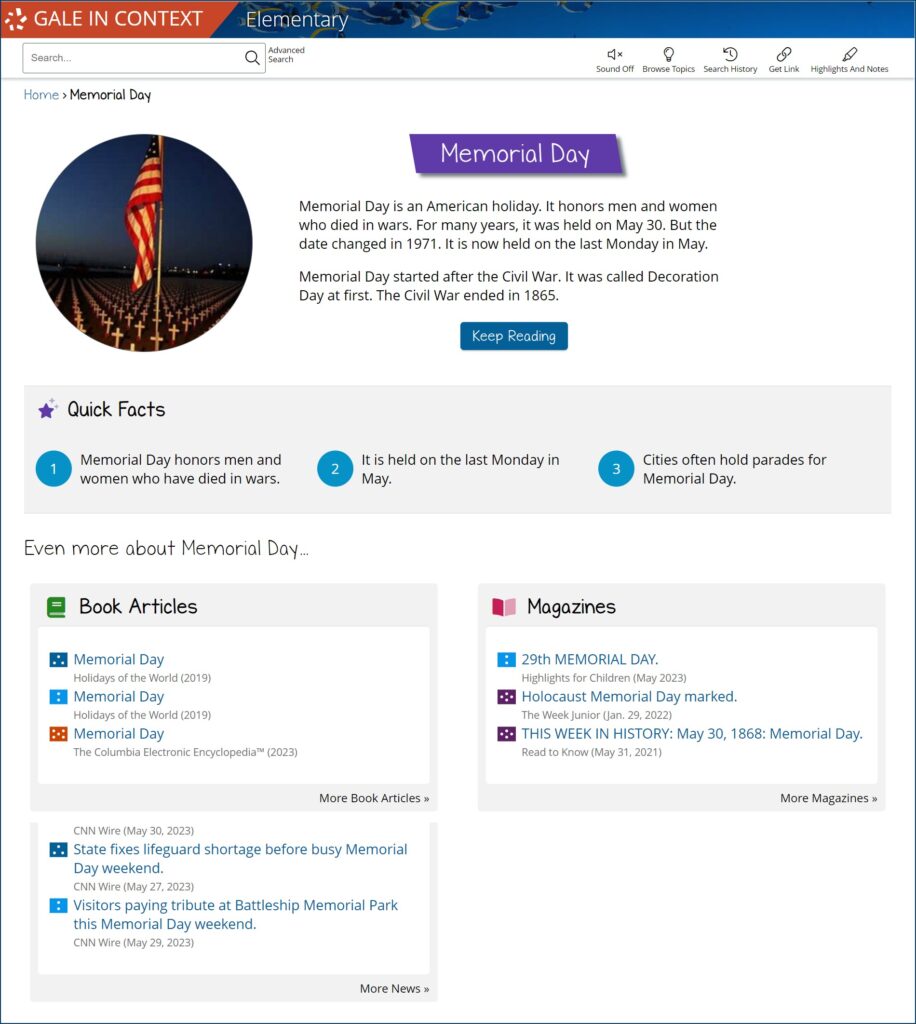A Pew Research study found that 61% of people under 40 have an immediate family member who currently serves or has served in the military. Of those, 1.6 million children have a parent who is either an active duty serviceperson or in a reserve unit.
Yet, many elementary students don’t understand why the last Monday in May is a holiday—much less the fact that it’s meant to be a day of commemoration for the military men and women who have lost their lives in war.
Finding the time at the end of the school year to squeeze another lesson in before you send your students off for summer vacation can be challenging, but Gale In Context: Elementary is here to support educators with our Memorial Day portal. From a Highlights for Children article on how to make a patriotic wreath to encyclopedia entries with built-in vocabulary support from Holidays of the World, you’ll find everything you need to get your students talking, thinking, and creating as they learn about Memorial Day.

Create a Memorial Day Mural
You can’t discuss Memorial Day without covering tough topics, including war and death. Your students might not have experience with these questions in a direct, concrete way. Help your learners process these big ideas by encouraging them to create a Memorial Day mural centered around their learning about the holiday.
Spread out long sheets of butcher paper, roll out the supply cart, and encourage students to work together as they draw symbols, words, scenery, and people that come to mind when they think about Memorial Day. Elementary has reference resources for inspiration, including photographs and illustrated magazine articles.
Invite Veterans to Share Their Stories
Who better to share what Memorial Day means to them than veterans themselves? But it also shows your guest speakers that their stories and experiences matter.
If you don’t have connections to veterans in the community, StoryCorps—a non-profit archival project that partners with the Library of Congress—has a collection of Memorial Day videos in which everyday people from across the country share their personal stories about loss, grief, and remembrance.
Take a Tour of Virtual Memorials
Once your students have learned about the history of Memorial Day, you can help them understand how their lives have been commemorated. Several online virtual tours and exhibits are available:
- The National Museum of American History has an online archive of The Price of Freedom: Americans at War exhibit, which explores how war impacts“citizen soldiers, their families, and communities.”
- A tour of the Normandy American Cemetary is available through Google Arts & Culture. It allows students to virtually explore the final resting place of American soldiers lost in World War II. Consider pairing it with the official Friends of the National World War II Memorial video tour.
- Take your learners behind the scenes of the construction of the Vietnam War Memorial with high-quality scans of primary source materials from the U.S. National Archives. This collection includes documents opposing its construction, which could open conversations with upper elementary students about different interpretations of art and how it can mean different things to different people, depending on their experiences.
- For a more structured tour with a curator, the National Veterans Memorial and Museum lets educators book a Zoom-based, 60-minute virtual field trip for $125. The guide will personalize your tour to meet your class’s grade level and learning objectives.
Write Letters to Service Members
After learning about Memorial Day’s history as a day of honoring the fallen, your students can share words of encouragement and appreciation with the family members of fallen heroes by participating in the Tragedy Assistance Program for Survivors (TAPS) Word of Remembrance Letter Campaign.
The program gathers handwritten letters and distributes them during their TAPS seminar weekends, during which those grieving the death of a loved one in the military gather for support and connection. They also provide a handy guide on suggested verbiage and language to avoid, which is an excellent scaffold for students struggling to think of the right words to share.
Create Poppy Flowers During Storytime
One of the most recognized symbols of Memorial Day is the red poppy, inspired by Canadian soldier Major John McCrae’s poem In Flanders Fields. In it, he describes the experience of burying a friend after the Battle of Ypres in World War I.
After reading McCrae’s poem, an American woman named Moina Michael was so touched by the poem that she wrote her own piece, We Shall Keep the Faith, and began selling poppy corsages as a fundraiser for veterans and their families.
Today, Americans wear red poppies on Memorial Day as a tribute to soldiers who sacrificed their lives while serving our country. Making foam versions of the scarlet flower can provide younger learners with an activity to keep their hands busy while listening to a thematic story.
Here are a few of our favorite Memorial Day story recommendations for elementary students:
- The Poppy Lady: Moina Belle Michael and Her Tribute to Veterans by Barbara Elizabeth Walsh
- A Day for Rememberin’: Inspired by the True Events of the First Memorial Day by Leah Henderson
- The Memorial Day Mission by Debbie A. Taylor
- In Flanders Fields by Linda Granfield
- Postcards from a War by Vanita Oelschlager
- The Wall by Eve Bunting
Find Resources for Memorial Day and More on Gale In Context: Elementary
When teaching students about the sacrifice that gives meaning to Memorial Day, you don’t have to spend countless hours combing through search results to find resources that accommodate their home languages and Lexile levels. With Gale In Context: Elementary, you can access rich multimedia content across thousands of topics and a suite of tools to help your elementary learners become confident, skilled researchers.
To learn more about Gale In Context: Elementary and its positive impact in the classroom, reach out to your local representative.

